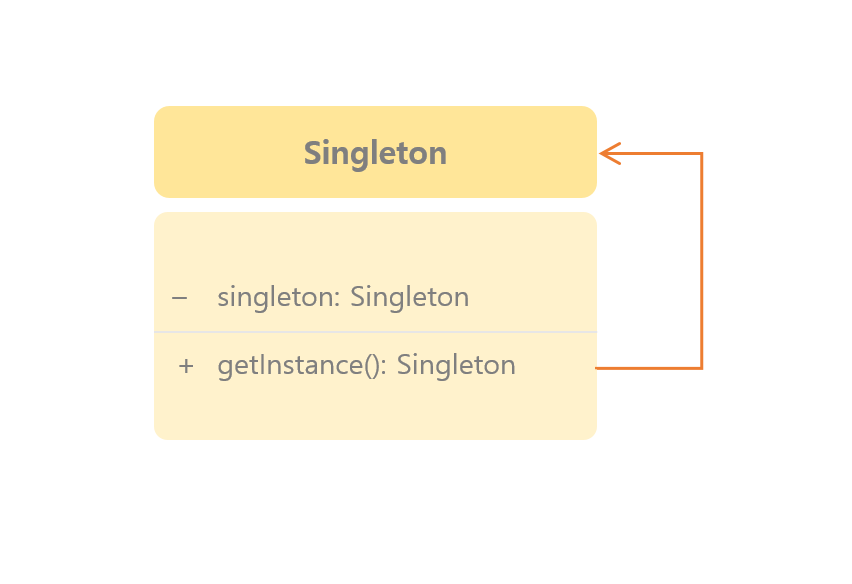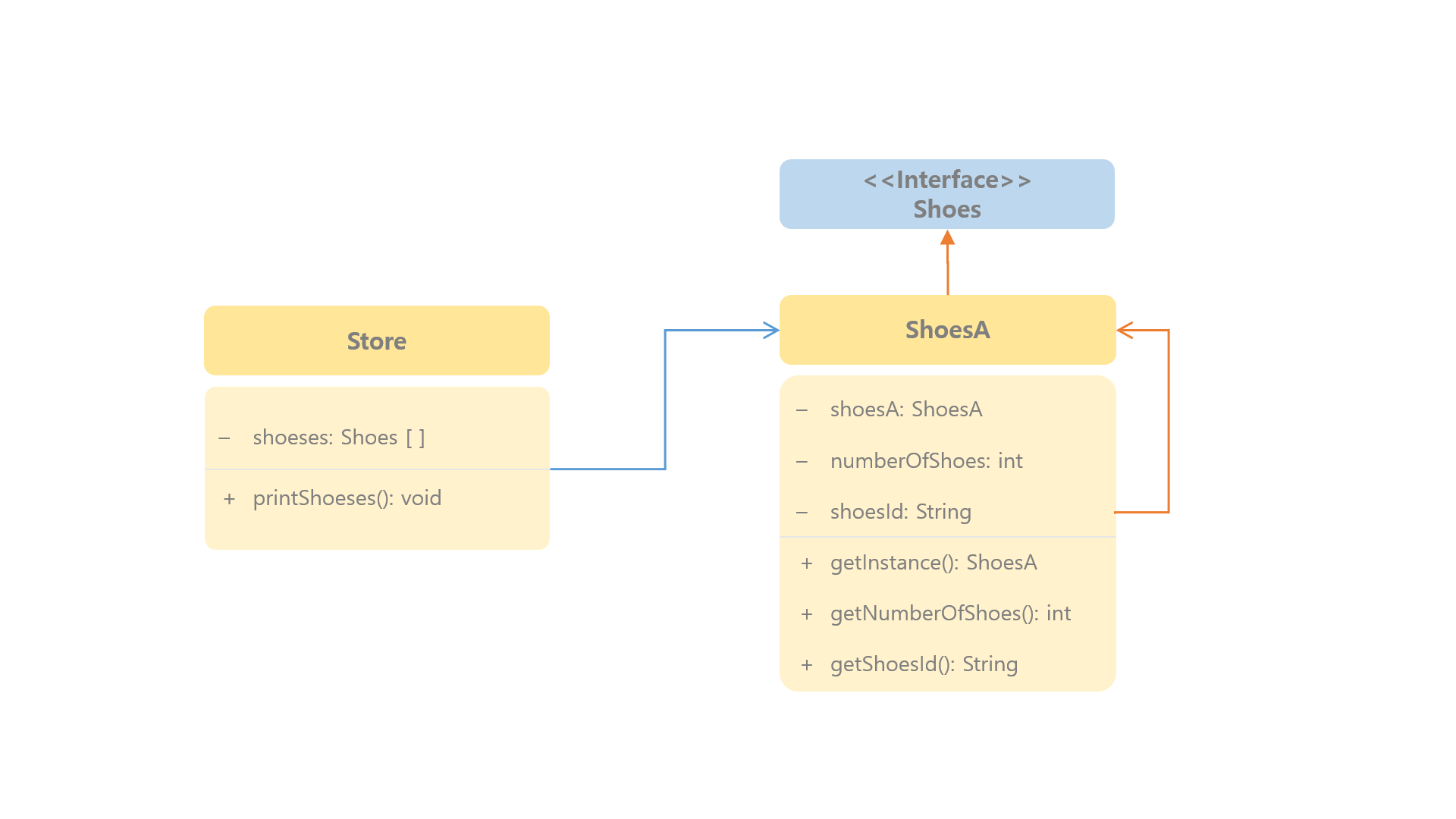싱글톤
전역 변수를 사용하지 않고 객체를 하나만 생성하도록 하며, 생성된 객체를 어디에서든 참조할 수 있도록 하는 패턴
- 하나의 인스턴스를 메모리에 등록하여 여러 스레드가 동시에 해당 인스턴스를 공유하여 사용하게끔 할 수 있으므로, 요청이 많은 곳에서 사용하면 효율을 높일 수 있습니다.
- 인스턴스가 절대적으로 한 개만 존재하는 것을 보증하고자 사용합니다.
다이어그램

- getInstance 메서드를 통해 모든 클라이언트에게 동일한 인스턴스를 반환합니다.
어떤 경우에 사용할까?
- 위에서 언급했듯이 인스턴스가 한 개만 존재하도록 제한하고자 할 때 사용합니다.
- 인스턴스의 잦은 생성으로 인한 메모리 낭비를 방지하고자 할 때 사용합니다.
- 공통된 객체를 여러 곳에서 이용할 때, 일일이 전달하기가 번거롭기 때문에 싱글톤 패턴을 이용하여 어디서든 해당 인스턴스에 접근하게 할 수 있습니다.
- DBCP(Database Connection Pool): DB와 연결하는 커넥션을 미리 생성해두고 풀에 저장해두었다가 필요할 때 꺼내쓰고, 사용 후 반환하는 기법. 각각의 연결 요청에 따라 인스턴스를 생성하는 것은 에러 이슈가 발생합니다. 싱글톤 패턴을 이용해 구현하므로써 무분별한 객체 생성을 막을 수 있습니다.
- Logger(로거): 계측, 수집한 각종 데이터를 보존하는 장치. 로그를 남길 때마다 로거 객체를 생성하는 것은 비효율적이기 때문에 싱글톤 패턴으로 시스템 자원 소모를 줄일 수 있습니다.
장점
위에 대부분 나온 부분이지만 간단히 다시 정리해보겠습니다.
- 메모리 낭비를 줄인다.
- 두 번째 이용부터는 객체 로딩 시간이 현저히 줄어 성능이 좋아진다.
- 싱글톤 인스턴스를 이용하는 다른 클래스들의 인스턴스들이 데이터를 공유하기 쉽다.
단점
- 싱글톤 인스턴스에 의해 너무 많은 데이터를 공유시킬 경우 다른 클래스의 인스턴스들 간의 결합도가 높아져 OCP을 위반하게 된다.
- OCP(Open-Closed Princitle): 소프트웨어 개체는 확장에 대해서는 열려있어야 하고, 수정에 대해서는 닫혀있어야 한다는 프로그래밍 원칙
- 위와 같은 이유로 수정이 어려워지고 유지보수의 비용이 높아질 수 있습니다.
- 멀티 스레드 환경에서 동기화 처리를 하지 않을 경우, 2개 이상의 인스턴스가 생성될 수 있습니다.
- 각 스레드마다 동일 메모리를 공유하는 것이 아닌 별도 메모리 공간에서 변수를 읽어오기 때문에 각 스레드마다 동일한 변수의 값을 다르게 기억할 수 있습니다.
- sychronized 키워드로 방지할 수 있습니다. 하단 예시를 참고해주세요.
- 코드가 복잡해질 수 있습니다.
예시
여러 가게에서 한 물류센터에 A 신발을 받아와 판매를 한다고 할 때, 가게 객체에선 A 신발의 객체를 공유하도록 한다고 생각하고 예시를 만들어 보았습니다.
즉 A 신발을 파는 모든 가게에선 물류 센터 내의 신발 개수를 공유합니다.
사실 실제 이런 경우라면 당연히 다른 방법을 쓰겠지만.. 싱글톤 특성인 요소 간 공유 위주로 설명하기 위한 단순한 예를 가져왔습니다.

Shoes
interface Shoes{
public int getNumberOfShoes();
public String getShoesId();
public void setNumberOfShoes(int numberOfShoes);
public void setShoesId(String shoesId);
}
ShoesA
class ShoesA implements Shoes{
private static ShoesA shoesA = new ShoesA();
private String shoesId;
private int numberOfShoes;
private ShoesA(){}
public static ShoesA getInstance(){
return ShoesA.shoesA;
}
public int getNumberOfShoes(){
return this.numberOfShoes;
}
public String getShoesId(){
return this.shoesId;
}
public void setNumberOfShoes(int numberOfShoes){
this.numberOfShoes = numberOfShoes;
}
public void setShoesId(String shoesId) {
this.shoesId = shoesId;
}
}
Store
class Store{
ArrayList<Shoes> shoeses;
public Store(){
this.shoeses = new ArrayList<Shoes>();
}
public void addShoes(Shoes shoes) {
// 한 신발에 대한 객체는 한 번만 저장
if(!shoeses.contains(shoes))
shoeses.add(shoes);
}
public void sellShoes(Shoes shoes, int number){
shoes.setNumberOfShoes(shoes.getNumberOfShoes()-number);
}
public void printShoeses(){
System.out.println(this);
for(Shoes shoes:shoeses){
System.out.println(shoes.getShoesId()+": "+shoes.getNumberOfShoes());
}
}
}
Main
class Main {
public static void main(String[] args) {
Store ShoesMarket = new Store();
Store ShoesWorld = new Store();
// 물류센터
ShoesA.getInstance().setShoesId("asd1234");
ShoesA.getInstance().setNumberOfShoes(1024);
// 가게에서 신발A 판매 시작
ShoesMarket.addShoes(ShoesA.getInstance());
ShoesWorld.addShoes(ShoesA.getInstance());
// 재고 확인
ShoesMarket.printShoeses();
ShoesWorld.printShoeses();
// 신발 판매
ShoesA shoesA = ShoesA.getInstance();
ShoesMarket.sellShoes(shoesA, 3);
// 재고 확인
System.out.println("----------ShoesMarket에서 신발A 3켤레 판매 후----------");
ShoesMarket.printShoeses();
ShoesWorld.printShoeses();
}
}
출력
Store@27716f4
asd1234: 1024
Store@8efb846
asd1234: 1024
----------ShoesMarket에서 신발A 3켤레 판매 후----------
Store@27716f4
asd1234: 1021
Store@8efb846
asd1234: 1021
한 가게에서 신발A를 팔았을 때 다른 가게에서도 신발A에 대한 수량이 바뀐 것을 확인할 수 있습니다.
멀티 스레드 환경에서 싱글톤
위와 다르게 멀티 스레드에서의 싱글톤을 알아보기 위해 더 단순한 형태로 두 클래스를 만들었습니다.
Person - 싱글톤 인스턴스를 호출할 스레드
class Person extends Thread {
int id;
public Person(int id) {
this.id = id;
}
public void run() {
Apple.getInstance().print("Person ID: " + this.id + " / Apple: " + Apple.getInstance().toString());
}
}
Apple - 싱글톤 클래스
class Apple{
private static Apple apple = new Apple();
private Apple() {}
public static Apple getInstance() {
return apple;
}
public void print(String str) {
System.out.println(str);
}
}
Main
class Main {
public static void main(String[] args){
int maxStore = 10;
Person[] People = new Person[maxStore];
for (int i = 0; i < maxStore; i++) {
People[i] = new Person(i);
People[i].start();
}
}
}
출력
Person ID: 6 / Apple: Apple@c7b723d
Person ID: 1 / Apple: Apple@c7b723d
Person ID: 9 / Apple: Apple@c7b723d
Person ID: 5 / Apple: Apple@c7b723d
Person ID: 2 / Apple: Apple@c7b723d
Person ID: 4 / Apple: Apple@c7b723d
Person ID: 8 / Apple: Apple@c7b723d
Person ID: 3 / Apple: Apple@c7b723d
Person ID: 7 / Apple: Apple@c7b723d
Person ID: 0 / Apple: Apple@c7b723d
여러 스레드에서 호출했지만 싱글톤 특성에 맞게 같은 객체가 반환됨을 확인할 수 있습니다.
이때 Apple 내의 공통적인 필드를 여러 스레드에서 수정한다면 어떻게 될까요?
Apple - count 변수 공유
class Apple {
private static Apple apple = new Apple();
private int count = 0;
private Apple() {
}
public static Apple getInstance() {
return apple;
}
public void print(String str) {
count++;
System.out.println(str + " / Count: " + this.count);
}
}
count 변수를 추가하고 print 메소드에서 수정 후 함께 출력해줍니다.
위와 동일한 Main을 돌리면 다음처럼 출력됩니다.
Person ID: 0 / Apple: Apple@1db55e5d / Count: 1
Person ID: 1 / Apple: Apple@1db55e5d / Count: 5
Person ID: 3 / Apple: Apple@1db55e5d / Count: 4
Person ID: 4 / Apple: Apple@1db55e5d / Count: 4
Person ID: 5 / Apple: Apple@1db55e5d / Count: 6
Person ID: 2 / Apple: Apple@1db55e5d / Count: 2
Person ID: 6 / Apple: Apple@1db55e5d / Count: 7
Person ID: 9 / Apple: Apple@1db55e5d / Count: 8
Person ID: 8 / Apple: Apple@1db55e5d / Count: 8
Person ID: 7 / Apple: Apple@1db55e5d / Count: 9
Count 부분을 보면 같은 Apple 객체를 사용하지만 전혀 동기화가 되지 않는 모습을 볼 수 있습니다.
sychronized
synchronized 키워드를 여러 스레드가 동시에 접근하지 못하게 할 곳 (동기화가 필요한 부분)에 추가합니다.
저는 count에 대한 수정이 있는 print 메소드에 추가했습니다.
Apple
class Apple {
private static Apple apple = new Apple();
private int count = 0;
private Apple() {
}
public static Apple getInstance() {
return apple;
}
public synchronized void print(String str) {
count++;
System.out.println(str + " / Count: " + this.count);
}
}
다시 동일한 Main을 run하면 다음처럼 출력 됩니다.
출력
Person ID: 2 / Apple: Apple@73c124cd / Count: 1
Person ID: 9 / Apple: Apple@73c124cd / Count: 2
Person ID: 8 / Apple: Apple@73c124cd / Count: 3
Person ID: 1 / Apple: Apple@73c124cd / Count: 4
Person ID: 5 / Apple: Apple@73c124cd / Count: 5
Person ID: 4 / Apple: Apple@73c124cd / Count: 6
Person ID: 6 / Apple: Apple@73c124cd / Count: 7
Person ID: 7 / Apple: Apple@73c124cd / Count: 8
Person ID: 3 / Apple: Apple@73c124cd / Count: 9
Person ID: 0 / Apple: Apple@73c124cd / Count: 10
count가 접근되는 순서대로 수정되었고, 동기화가 잘 되어 중복이 없음을 확인할 수 있습니다.
싱글톤 vs 정적 클래스 (C#)
정적 클래스란 인스턴스를 만들 수 없는 클래스로, 모든 멤버를 static으로 선언해야 합니다.
전역적으로 접근해야 하는 유틸리티 클래스의 경우 정적 클래스로 만들면 유용하게 사용할 수 있습니다.
인스턴스를 가질 수 없고 메소드만 사용하기 때문에 절차지향적인 함수에 더 가깝습니다. 즉, OOP(Object Oriented Programming)의 원칙을 따라가지 않습니다.
| 싱글톤 | 정적 클래스 | |
|---|---|---|
| 원리 | 하나의 인스턴스를 생성해 재사용 | 인스턴스를 생성하지 않고 정적 멤버에 접근 |
| 인터페이스 구현 | 가능 | 불가능 |
| OOP | O | X |
| Override | 가능 | 불가능 |
| Load | 필요할 때 Lazy Initialization 가능 | 정적 바인딩되어 컴파일 시간에 Load |
| 성능 | 상대적으로 느림 | 정적 바인딩을 이용해 빠름 |
- 싱글톤의 Early Initialization: 클래스가 로드될 때 인스턴스가 생성되는 것으로, 위의 예시는 다 이 방법을 사용했습니다.
- 가장 간단하지만 클라이언트에서 사용하지 않더라도 인스턴스가 항상 생성되는 것이 단점입니다.
class SingltonEarly{ private static SingltonEarly singltonEarly = new SingltonEarly(); ... }
- 가장 간단하지만 클라이언트에서 사용하지 않더라도 인스턴스가 항상 생성되는 것이 단점입니다.
- 싱글톤의 Lazy Initialization: getInstance를 호출할 때 객체를 생성하는 것으로 인스턴스가 필요할 때 생성하므로써, Early Initialization의 단점을 보완합니다.
- 이 방법은 멀티 스레드에서 2개 이상의 인스턴스가 생성될 수 있으니 동기화를 해주어야 합니다.
- 아래는 동기화가 되지 않은 상태입니다.
class SingltonLazy{ private static SingltonLazy singltonLazy; public static SingltonLazy getInstance(){ if(singltonLazy == null){ singltonLazy = new SingltonLazy(); } return singltonLazy; } ... }
끝
싱글톤 패턴은 제약이 확실해야 하는 만큼 구현이 복잡하고 다양한 방법이 있네요.
직렬화/역직렬화 관련 내용은 빼고 정리했는데도 글이 엄청 길어졌습니다.
직렬화/역직렬화 자체에 대한 이해가 부족해 다음에 다시 보기로 하고 넘겼지만 관련 내용은 참고 링크 중 가장 마지막 링크로 가시면 보실 수 있습니다.
참고
- https://jeong-pro.tistory.com/86
- https://webdevtechblog.com/%EC%8B%B1%EA%B8%80%ED%84%B4-%ED%8C%A8%ED%84%B4-singleton-pattern-db75ed29c36
- https://mygumi.tistory.com/265
- https://javaplant.tistory.com/21
- https://twpower.github.io/227-singleton-pattern-concept-and-example
- https://yaboong.github.io/design-pattern/2018/09/28/thread-safe-singleton-patterns/
감사합니다.
Text by Chaelin. Photographs by Chaelin, Unsplash.